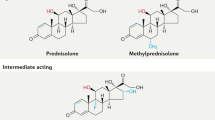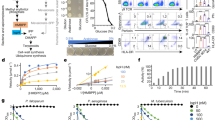Abstract
The glucocorticoid receptor (GR) belongs to a superfamily of ligand-regulated nuclear steroid hormone receptors. The steps in the signal transduction pathway leading to the biological effects of glucocorticoids (GCs) include sequentially binding of the steroid to the GR ligand binding domain (LBD), receptor transformation1–3, nuclear translocation and either positive or negative gene transactivation4. Rifampicin (RIF) is a macrocyclic antibiotic used as an antituberculosis agent5. As the incidence of tuberculosis has been increasing, in part because of the AIDS epidemic, a growing number of patients are being exposed to the adverse effects of this antibiotic6. Indeed, this compound, as are the GCs (ref. 7), is often implicated in noxious drug interactions, because of its strong ability to induce drug-metabolizing enzymes8,9. Moreover, in humans, RIF, as are the GCs (ref. 10), has been described as a potential immunodepressor, associated notably with the reduction of mitogenic responsiveness of human peripheral blood lymphocytes11,12. Here, we report that RIF activates the human glucocorticoid receptor (hGR). Transient expression of wild-type, deleted or mutated GRs; sucrose density gradient sedimentation; and the BIAcore technique strongly suggest that RIF binds to the receptor with the physiological consequence that this antibiotic acts as an immunodepressor. Given the wide use of RIF in the treatment of coinfection of tuberculosis and HIV, this report is highly relevant to current medical practice.
This is a preview of subscription content, access via your institution
Access options
Subscribe to this journal
Receive 12 print issues and online access
$209.00 per year
only $17.42 per issue
Buy this article
- Purchase on Springer Link
- Instant access to full article PDF
Prices may be subject to local taxes which are calculated during checkout
Similar content being viewed by others
References
Yamamoto, K.R. Steroid receptor regulated transcription of specific gene and gene networks. Annu. Rev. Cenet. 19, 209–211 (1985).
Green, S. & Chambon, P. Nuclear receptors enhance our understanding of transcription regulation. Trends Genet. 4, 309–314 (1988).
Beato, M. Gene regulation by steroid hormones. Cell 56, 335–339 (1989).
Ringold, G.M. Steroid-hormone regulation of gene expression. Annu. Rev. Pharmacol. Toxicol. 25, 529–566 (1985).
Mitchison, D.A. Understanding the chemotherapy of tuberculosis—current problems [The Garrod lecture]. J. Antimicrob. Chemother. 29(5), 477–493 (1992).
Mitchell, L., Wendon, J., Fitt, S. & Williams, R. Anti-tuberculous therapy and acute liver failure. Lancet 4, 555–556 (1995).
Corcos, L. Phenobarbital and dexamethasone induce expression of cytochrome P450 genes from subfamilies IIB, IIC, and IIIA in mouse liver. Drug. Metab. Dispos. 20, 797–801 (1992)
Cresteil, T. et al. Induction of drug-metabolizing enzymes by tricyclic antide-pressants in human liver: Characterization and partial resolution of cytochromes P450. Br. J. Gin. Pharmacol. 16, 651–657 (1983).
Pichard, L., et al. Effect of corticosteroids on the expression of cytochromes P450 and on cyclosporin A oxidase activity in primary cultures of human hepatocytes. Mol. Pharmacol. 41, 1047–1055 (1992).
O'Malley, B.W. & Tsai, M.J. Molecular pathways of steroid receptor action. Biol. Reprod. 46(2), 163–167 (1992).
Ibrahim, M.S., Maged, Z.A., Haron, A., Khalil, R.Y. & Attllah, A.M. Antibiotics and immunity: Effect of antibiotics on natural killer, antibody dependent cell-mediated cytotoxicity and antibody production. Chemioterapia 6, 426–430 (1987).
Nessi, R., Pallanza, R. & Fowst, G. Rifampicin and Immunosuppression. Arzneim.-Forsch. 24(5), 832–836 (1974).
Baumann, H., Jahreis, G.P. & Morella, K.K. Interaction of cytokine—and glucocorticoid—response elements of acute-phase plasma protein genes: Importance of glucocorticoid beta-fibrinogen genes. J. Biol.Chem. 265, 22275–22281 (1990).
Gradin, K., Whitelaw, M.L., Toftgard, R., Poellinger, L. & Berghard, A.J. A tyrosine kinase-dependent pathway regulates ligand-dependent activation of the dioxin receptor in human keratinocytes. J. Biol. Chem. 269, 23800–23807 (1994).
Ning, Y.-M. & Sánchez, E.R. Potentiation of glucocorticoid receptor-mediated gene expression by the immunophilin ligands FK506 and rapamycin. J. Biol. Chem. 268, 6073–6076 (1993).
Green, S. & Chambon, P. Oestradiol induction of a glucocorticoid-responsive gene by a chimaeric receptor. Nature 325, 7578 (1987).
Kumar, V., et al. Functional domains of the human estrogen receptor. Cell 51, 941–951 (1987).
McGregor, D.B., Edwards, I., Wolf, C.R., Forrester, L.M. & Caspary, W.J. Endogenous xenobiotic enzyme levels in mammalian cells. Mutat. Res. 261, 29–39 (1991).
Moguilewsky, M. & Philibert, D. RU 38486: Potent antiglucocorticoid activity correlated with strong binding to the cytosolic glucocorticoid receptor followed by an impaired activation. J. Steroid. Biochem. 20, 271–276 (1984).
Lanford, R.E., Carey, K.D., Estlack, L.E., Smith, G.C. & Hay, R.V. Analysis of plasma protein synthesis in long-term primary cultures of baboon hepatocytes maintained in a serum-free medium. In Vitro Cell. Dev. Biol. 25, 174–182 (1989).
Ourlin, J.C., Vilarem, M.J., Daujat, M., Harricanne, M.C. & Maurel, P. Lipid-mediated transfection of normal adult human hepatocytes in primary culture. Anal. Biochem. 247, 34–44 (1997).
Benhamou, B. et al. A single amino acid that determines the sensitivity of progesterone receptors to RU486. Science 256, 206–209 (1992).
Wurtz, J.M. et al. A canonical structure for the ligand-binding domain of nuclear receptors. Nature Struct Biol. 3, 87–94 (1996).
Denis, M., Poellinger, L., Wikstöm A.C. & Gustafsson, J. Requirement of hormone for thermal conversion of the glucocorticoid receptor to a DNA-binding state. Nature 333, 686–688 (1988).
Bhakoo, H.S., Paolini, N.S., Milholland, R.J., Lopez, R.E. & Rosen, F. Clucocorticoid receptors and the effect of glucocorticoids on the growth of B16 melanoma. Cancer Res. 41, 1695–1701 (1981).
Fägerstam, L.G. & Karlsson, R. Biosensor techniques. in Immunochemistry (eds. Van Oss, C.J., & Van Regenmorte, M.) 949–970 (Marcel Dekker, New York, 1993).
Fägerstam, L.G. & O'Shannessy, D.J. Surface plasmon resonance detection in affinity technologies. Handb. Affinity Chromatogr. 63, 229–252 (1993).
Malmqvist, M. Biospecific interaction analysis using biosensor technology. Nature 361, 186–187 (1993).
Yu, C., Warriar, N. & Govindan, M.V. Cysteines 638 and 665 in the hormone binding domain of human glucocorticoid receptor define the specificity to glucocorticoid receptor. Biochemistry 34, 14163–14173 (1995).
Xu, M., Chakraborti, P.K., Garabedian, M.J., Yamamoto, K.R. & Simons, S.S. Molecular structure of glucocorticoid receptor domains is not equivalent to functional independence. J. Biol. Chem. 271, 21430–21438 (1996).
Simons, S.S., Sistare, F.D. & Chakraborti, P.K. Steroid binding activity is retained in a 16-kDa fragment of the steroid binding domain of rat glucocorticoid receptors. J. Biol. Chem. 254, 14493–14497 (1989).
Kraus, W.L., Mclnerney, E.M. & Katzenellenbogen, B.S. Ligand-dependent tran-scriptionally productive association of the amino and carboxyl-terminal regions of a steroid hormone nuclear receptor. Proc. Natl. Acad. Sci. USA 92, 12314–12318 (1995).
Langley, E., Zhou, Z., & Vilson, E.M. Evidence for an anti-parallel orientation of the ligand-activated human androgen receptor dimer. J. Biol. Chem. 270, 29983–29990 (1995).
Vacca, A. et al. Glucocorticoid receptor-mediated suppression of the Interleukin 2 gene expression through impairment of the cooperativity between nuclear factor of activated T cells and AP-1 enhancer elements. J. Exp. Med. 175, 637–646 (1992).
Jonat, C., et al. Antitumor promotion and anti-inflammation down-modulation of AP-1 (Fos/Jun) activity by glucocorticoid hormone. Cell 62, 1189–1204 (1990).
Watkins, P.B. Role of cytochrome P450 in drug metabolism and hepatotoxicity. Semin. Liver. Dis. 10, 235–250 (1990).
Gao, X. & Huang, L. A novel cationic liposome, reagent for efficient transfection of mammalian cells. Biochem. Biophys. Res. Comm. 179, 280–285 (1991).
Pichard, L. et al. Cyclosporin A drug interaction: Screening for inducers and inhibitors of cytochrome P-450 (cyclosporin A oxidase) in primary cultures of human hepatocytes and liver microsomes. Drug. Metab. Dispos. 18, 595–606 (1990).
Durand, D.B., et al. Characterization of antigen receptor response elements within the interleukin-2 enhancer. Mol. Cell. Biol. 8, 1715–1724 (1988).
Angel, P., et al. Phorbol ester-inducible genes contain a common cis element recognized by a TPA-modulated trans-acting factor. Cell 49, 729–739 (1990).
Neuman, J.R., Morency, C.A. & Russian, K.O., A novel rapid assay for chloram-phenicol acetyltransferase gene expression. Biotechniques 5, 444 (1987).
O'Shanessy, D.J., Brigham-Burke, M., Sonseson, K.K., Hensley, P. & Brooks, I. Determination of rate and equilibrium binding constants for macromolecular interactions by surface plasmon resonance. Methods Enzymol. 249, 323–349 (1994).
Karlsson, R., Ross, H., Fägerstam, L. & Persson, B. Kinetic and concentration analysis using BIA technology. Methods 6, 99–110 (1994).
Author information
Authors and Affiliations
Corresponding author
Rights and permissions
About this article
Cite this article
Calleja, C., Pascussi, J., Mani, J. et al. The antibiotic rifampicin is a nonsteroidal ligand and activator of the human glucocorticoid receptor. Nat Med 4, 92–96 (1998). https://doi.org/10.1038/nm0198-092
Received:
Accepted:
Issue Date:
DOI: https://doi.org/10.1038/nm0198-092



